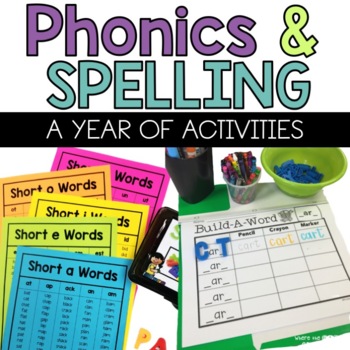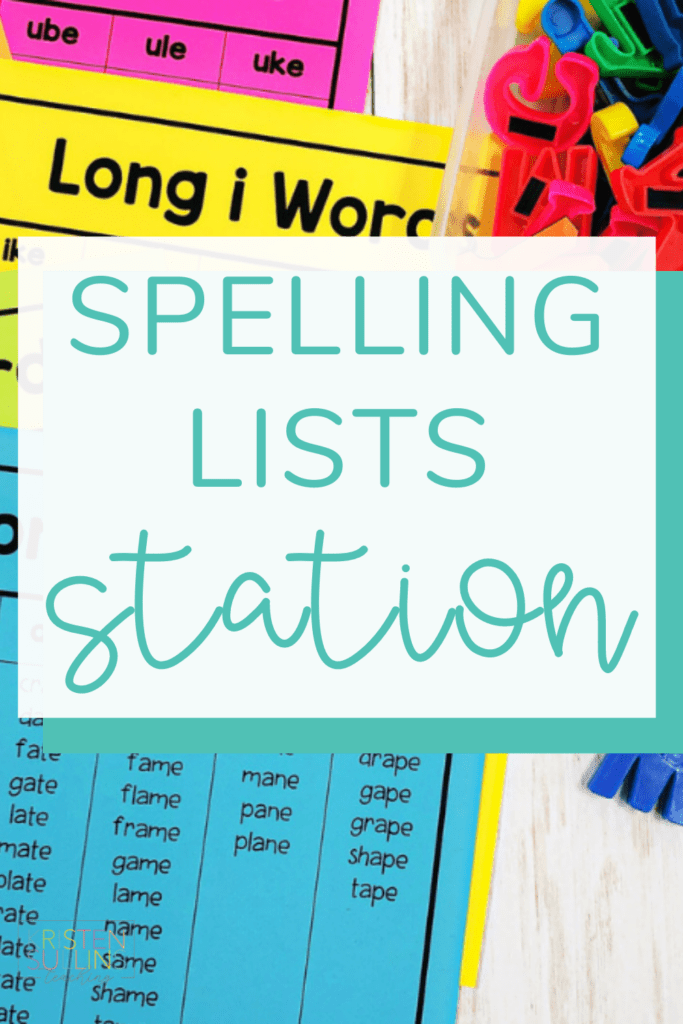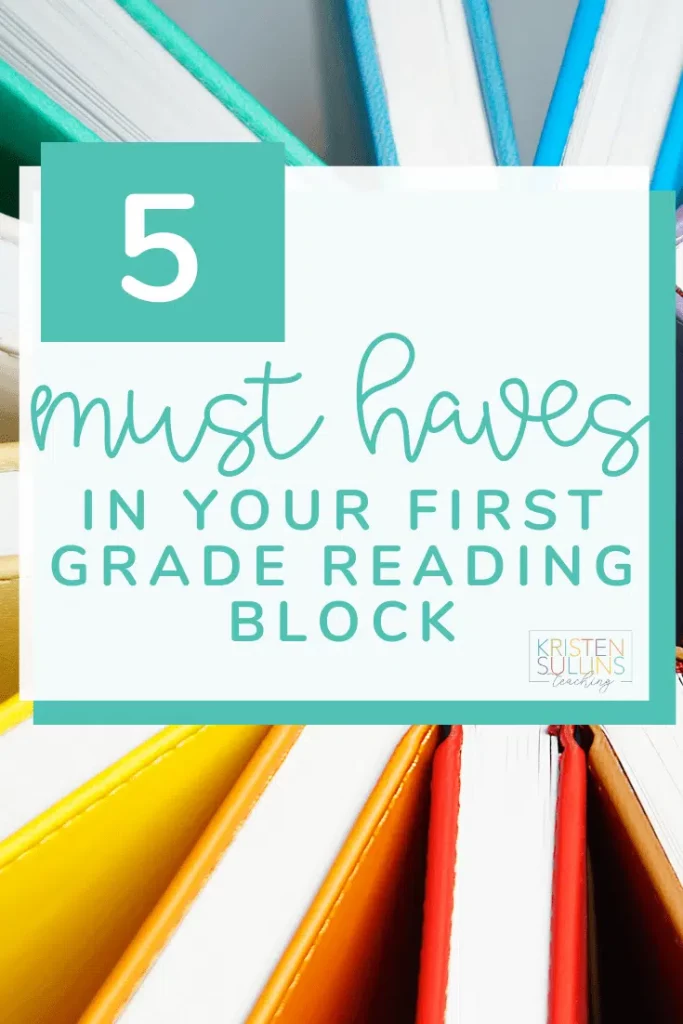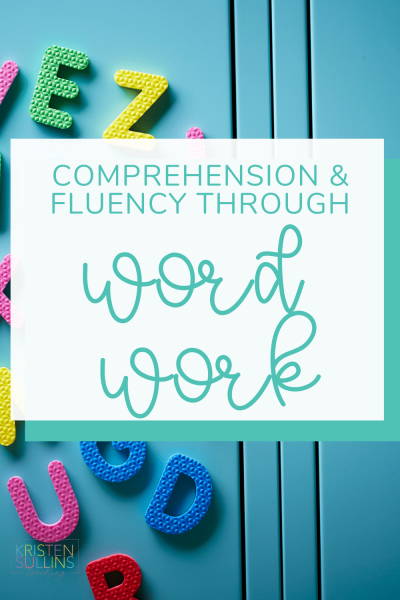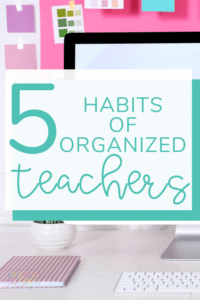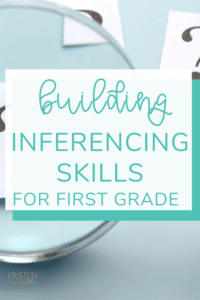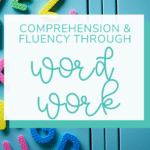Today I'm sharing with you how I designed my word work station for my first grade students to practice comprehension and fluency daily!
As we know, students need to have a strong background in decoding and vocabulary building to make reading possible.
The reading skills we are teaching, from individual letter knowledge to word reading and text-processing, are all vital components in students' abilities to read.
Comprehension requires fluid articulation of all the reading skills we teach our students.
The best way for them to hone these skills is through practice. My word work station is where I place a focus on this practice. Giving students time every day to practice these taught skills is so important.

Word Work in First Grade
There are tons of really great word work resources out there. From easy to distribute printables to creative manipulatives; like word family blocks, dice and much more.
Something that I’ve always focused on in my word work station was repetition and constant practice. I wanted my students to be able to identify rhyming words, decode and read fluently.
Something that I DID NOT think about was how being able to decode these words wasn’t enough, I needed to provide my students with a way to develop a deeper meaning behind the decoding.
Just because our students can read “Jack ran and kicked the ball” clearly and quickly, we want them to know what they read, remember the decoding strategies taught and apply them to reading and writing.
Comprehension work and fluency practice are both needed. This will help them not only read, but remember the words we are working on (oh hey there comprehension!).
Comprehension and Fluency in First Grade
The Why? – Why Comprehension and Fluency?
- Comprehension
As we know, comprehension is vital in reading and understanding text. We need to use this same logic when students are working on individual words. Including a comprehension component to my word work station was key. By allowing students to use strategies we have been practicing to decode words and then by giving them opportunities for understanding, I have seen a big improvement in my students' abilities to transfer their word work practice to sentence reading AND writing! Woowhoo!
- Fluency Practice
There have been a lot of differing opinions on fluency over the last decade (or maybe even longer, but I haven’t been teaching much longer than that). Our district has gone from using hard and fast fluency requirements and WPM’s (words per minute) during running records, to not focusing on fluency, to incorporating fluency guidelines to testing. There is so much information out there and it’s hard, as teachers, to know what is best! We do know that comprehension is the goal of reading and without having the ability to read smoothly and at a decent rate, it makes comprehension more difficult. So, with that all being said, I still feel that incorporating fluency practice is important!
The What – what am I doing?
It’s very simple to take word work practice and add in a comprehension element. Here’s how I decided to do it:
- Part A: Read the words, highlight/underline/box the focus sound, use it in a sentence and illustrate the sentence.
Whole group lesson example- (working on the boxed sound /ol/):
- Read the words: fall, ball, wall, tall
- Box the /ol/ sound: using a pencil draw a box around the glued sound – [all]
- Select a word and use it in a sentence. At the start of the year you can have students share allowed, or share with a neighbor. As the year progresses I have students record these sentences in a notebook. I have a vocabulary binder I’ve used, but I’ve also had students record these in a separate phonics notebook.
- Illustrate the sentence! This can be done with or without the written sentence, but make sure students are still recording the word. For example: they label their picture with the word work word(s).
Students can choose to do separate illustrations or one big illustration with labels.
- Part B: after finishing part A, display or distribute sentence strips that include words/spelling patterns that have been previously taught. I like having my students read these 3-5 times.
- First time – decode the sentence
- Second time – read it with your normal reading voice
- Third time – read it with a silly voice* (this can be done a couple times with different silly voices)
- Last time – read it with your inside voice (quietly in your head)
*silly voices can include: monster voice, witch voice, robot voice, a whisper, low voice, etc. My students LOVE reading with silly voices—- even my kiddos who don’t like reading yet! And yes, I say yet! Don’t forget the power of this word. Our students WILL be readers, we are here to help them get there and hopefully instill a love for reading along the way.
As the year progresses you can switch this up from working on individual words and sentences to simple readers. Fluency readers have gotten a bad wrap for how simplistic they are, and not very engaging, but they are great for practice. And if you allow students to add their own illustrations it makes it not only something they can better understand, but something that is their own. They become illustrators and are still working on fluency and comprehension.
The How – how is this used/implemented?
As with anything new, I always start introducing procedures to the whole group. We practice and then once they are comfortable with my expectations I release control and move the work into my word work station. Station time should be something all students are able to accomplish/work on in a given time period. However, some students may need additional help and support from you. For these students I make sure to provide them with small group word work instruction to help with the decoding, fluency and comprehension practice. This typically takes place during my targeted reading groups. These small group word work practices are great warmups for guided reading instruction, but can also be used as a whole small group lesson. It’s up to you how you want to mold these into your small group time. I change the way I work them in all the time! It depends on what works with the time I have and what it is my students need.
The When and Where – when are students doing this?
Students should be given plenty of opportunities to practice the reading strategies that are taught to the entire class. Word work time is a great time for the reinforcement of phonics understanding. It is during word work practice that students can take the focus sounds/spelling patterns and apply them to the practice of decoding. From there, students can use the words they’ve decoded and then build on their knowledge of those words.
For me, this time happens in small group stations and at my teacher's table. This depends on the students current understanding and reading abilities. Of course, like I’ve already said, I always start with whole group. I do, we do, you do!
Overall I have found that including a comprehension component into my students word work time has increased their overall understanding of the skills being taught. They are using, practicing and remembering concepts and then applying them to their reading and writing. This has been something I’ve been using for only a short time, but I’ve seen growth and my students are reaping the benefits. Yay!
Spelling Activities for First Grade
This year long Phonics and Spelling activity bundle is a 5-Part phonics kit for teachers to use when teaching students about spelling and phonics patterns (word families).
Here's what other teachers are saying:
Using this resource for center work at the end of the day. Students are very engaged and successful!
-Kelly S.
This is a fantastic collection of reading resources to use during guided reading groups! Some of my first graders are still working on phonics skills that will help them read fluently. I love this set!
-Ramona K.

